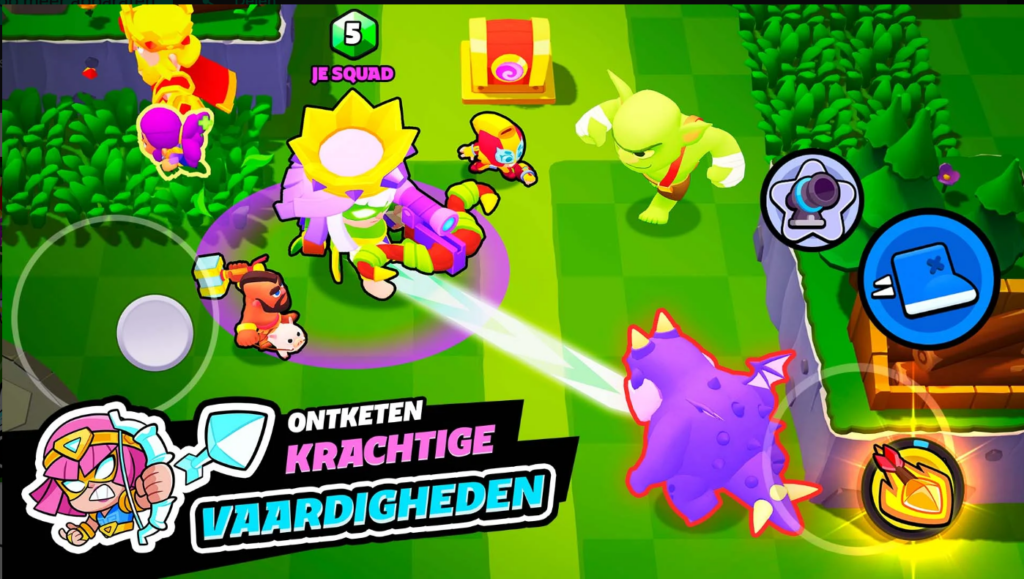Supercell doesn’t release games often. But when it does, the industry pays attention. With titles like Clash of Clans and Brawl Stars, the Finnish giant has carved out a niche where accessibility, tight gameplay loops, and monetization dance in a well-orchestrated rhythm. Their latest title, Squad Busters, entered the fray with ambition—and a few rough edges smoothed out from its earlier iterations. This review was not promoted or asked for by SuperCell, but was written based on my experience with the game.
Squad Busters vs. Brawl Stars – Familiar But Different
Before we dive into the whole “what is this new update about” thing, let’s do a quick rundown on the game you see all over the internet—Brawl Stars. On the surface, Squad Busters and Brawl Stars may seem to share DNA: both are short-session competitive games with colorful rosters and live multiplayer action. But that’s where the similarities end.
Brawl Stars thrives on PvP skill shots, real-time team coordination, and precise movement. It’s twitchy, fast, and intensely competitive. Squad Busters, on the other hand, is more about momentum-building and dynamic strategy. You start small, with a single unit, and gradually grow your squad by unlocking random characters mid-match. It’s part roguelike, part arena brawler, and part resource management.
Where Brawl Stars demands reaction time, Squad Busters rewards map awareness and decision-making. Do you chase a player, farm gold, or hunt for your next character? That split-second choice makes or breaks your squad. The unpredictability of your evolving team adds a layer of tactical chaos—fun when it works, frustrating when RNG doesn’t favor you. But Squad Busters changed!
From Baby to Squad Buster
Before its global release, Squad Busters underwent several soft launches and test builds. While fun, the early version of the game felt more like a chaotic experiment than a refined product. Characters were loosely balanced, the UI clunky, and the core loop shallow. SuperCell patched this, and the game became a religious thing that I played daily. It felt like a tactical brawlfest, which focused on gathering a crew of heroes to beat the crap out of the other squads. But like with all games, gameplay became ‘stale’ according to SuperCell, and they wanted to revamp and overhaul significant parts of the game. This was met with lukewarm responses, since the last updates from 2025 didn’t add much to the game – would this update ‘save’ the game? Fast forward to the current release, and it’s clear that Supercell listened to the feedback from the community, since the transformation is more than cosmetic.
The current Squad Busters is leaner, cleaner, and more confident in what it wants to be. Gameplay pacing is tighter, character abilities are more intuitive, and the overall match structure feels rewarding rather than frustrating. The randomized character pool system has been polished, pushing players to adapt rather than rely on meta-stacking. These aren’t just tweaks—they’re signs of a game maturing, even if you don’t like Squad Busters is new direction. It now offers a ‘bigger’ hero out of a roster of four, which you can complement with squadies to become the ultimate Hero-Squad buster. Yes, it feels like they took aspects from BrawlStars and League of Legends and added them into SquadBusters – and yes, it took some adjusting to it. But is it all bad? No, it just turned into a different game than what we grew up with.
The new hero system gives the game a more skill-based drive, with squadies feeling like expendable cannon fodder. They added two powers to each hero you can pick from, instead of the lists of perks you would unlock with each squadie and/or spell you picked up. This can often lead to thinking you have a pretty decent squad, but still getting annihilated by a well-timed arrow or a box thrown at your head. They still have to add Morris to the roster as a playable champion, and I think there is a lot of room for Squad Busters to grow, but it isn’t as bad as written on the Squad Busters Subreddit.
The Supercell Signature (and Its Cost)
Supercell games are rarely pay-to-win, but never entirely innocent of monetization strategies. Squad Busters follows suit. While the core gameplay isn’t locked behind paywalls, there’s a clear progression incentive to spend, especially when unlocking new characters or speeding up upgrades. That said, the production values are top-tier. The animations are fluid, the sound design snappy, and the menus are intuitive without feeling bloated. Supercell proves they know how to make a mobile game feel like a premium experience—even if it leans into familiar territory.
Conclusion
Squad Up, or Sit Out, that’s the big question here. Squad Busters isn’t just Brawl Stars with more characters—it’s a different beast entirely. It rewards a different type of thinking that combines strategy, adaptability, and squad synergy over raw reflexes. While it’s still finding its identity, the leap from its early version to this polished release is impressive. And with Supercell’s track record, it’s fair to expect steady improvements and content drops. Is it Supercell’s next Clash Royale? Maybe not. But it’s certainly not a misfire either. Squad Busters is worth the download if you’re looking for a mobile title that offers quick matches with depth underneath the surface.




